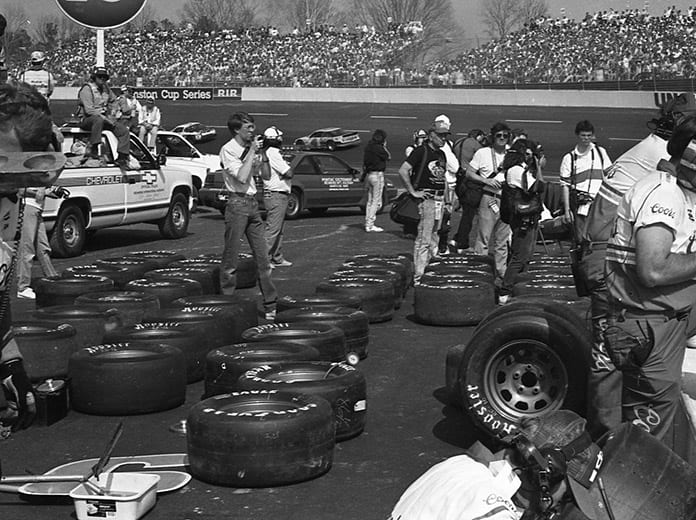Since April 1989, radial tires have been the standard for NASCAR’s top-three racing divisions. Prior to that change in design took place, bias-ply tires were used from the days drivers first entered NASCAR events, offering good side-by-side racing and challenges that had to be overcome.
The terms radial and bias-ply describe the internal construction of a tire. Radial tires came to NASCAR because of improved durability, but also because they were becoming more prominent in the marketplace.
In elementary terms, bias-ply tires were built by placing fabric cords laid at opposing angles to the ply underneath it, creating a crisscross pattern. Most bias-ply tires were four ply, indicating they had four layers of reinforcing fabric cords. For track use, crew chiefs could use “stagger” — the difference in circumference between the left-side tires and the right-side tires — by under inflating the left-side tires and the right-side rubber. Heat also expended them, improving the car’s ability to turn left through fluctuating air pressure.
In 1948, the year NASCAR was founded, Firestone Tire and Rubber Co. provided tires for open-wheel racing and began branching out to NASCAR’s newly formed arena. Two years later, Johnny Mantz won the inaugural Southern 500 at Darlington (S.C.) Raceway on hard-treaded truck tires similar to those used in Indy car racing.
In 1954, Goodyear Tire and Rubber Co. entered NASCAR with a plan to build tires for stock car racing. At the time, the majority of the circuit was made up of dirt and asphalt short tracks. Goodyear engineers. set out to create a tire that could withstand the high speeds generated at two relatively new superspeedways — Darlington Raceway, which was built in 1950, and the one-mile Raleigh (N.C.) Speedway that opened in 1952.
By the early 1960s, race tires were becoming wider and were designed to have more tread on the racing surface. The deaths of Jimmy Pardue in 1964 and Billy Wade in ’65 prompted the design of the inner liner, a tire within a tire that guarded against catastrophic blowouts such as the ones that took their lives. Throughout the mid to late 1960s, drivers Buddy Baker and Darel Dieringer bravely ran over objects on the track at high speeds to further enhance tire safety.
A tire controversy before the debut race at Talladega (Ala.) Superspeedway in September 1969 caused drivers to stage a walkout over safety. Firestone, the manufacturer of the tire, couldn’t made the tire hold up at high speeds. The company left NASCAR altogether in 1974. Its departure left Goodyear as the sole tire provider for the next 12 seasons.
Then, in 1986, a hostile takeover attempt and uncertainty of tire delivery prompted the sanctioning body to open the door to Hoosier Tire Co. While Goodyear employed 350,000 workers around the globe, Hoosier Tire Co., owned by Bob Newton, had only 16 employees in his Indiana stable.
H.A. “Humpy” Wheeler, former president of Charlotte Motor Speedway and a former representative for Firestone, knew the storm was brewing.
“It was reminiscent of the old Goodyear and Firestone days in Cup racing in the 1960s,” Wheeler said. “Then along comes Hoosier. I knew when they came in that tire was going to get real light. Hoosier ran a real soft tire and the softer you get, the faster you go. Goodyear didn’t want to take it that soft. The bias-ply tire was a much more comfortable tire to ride on for race drivers. Obviously, tire companies didn’t want them because they weren’t selling them as much. Both manufacturers got to the point where they were so on the edge their tires became prohibitively dangerous. And the tire companies never want danger.”
Entering Speedweeks at Daytona Int’l Speedway in 1988, Baker, Donnie Allison, Neil Bonnett, Lake Speed, Morgan Shepherd and Rick Wilson were among those using Hoosier tires.
